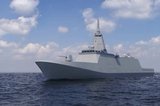F-35 makes first SRVL on HMS Queen Elizabeth
The first shipborne rolling vertical landing (SRVL) has been carried out by an F-35 Lightning fighter jet onboard the Royal Navy’s new aircraft carrier, HMS Queen Elizabeth, the navy announced on 15 October.
The SRVL method requires the jet to make a conventional landing approach, approaching the ship from behind at speed, before using thrust from its nozzle and lift created by air over the wings to touch down and gently come to a stop.
According to the navy, the UK is the only nation currently planning to use the manoeuvre, which will allow jets to land on board the carrier with heavier loads, meaning they won’t need to jettison fuel and weapons before landing.
HMS Queen Elizabeth is carrying out flying trials – on a deployment called Westlant 18 – along with escort ships HMS Monmouth and US destroyer USS Lassen.
The Royal Navy's two new aircraft carriers will support the navy across the globe. Construction of HMS Prince of Wales, the second aircraft carrier in the class, is nearing completion at the Rosyth shipbuilding yard. HMS Queen Elizabeth is on track to deploy on global operations from 2021.
More from Naval Warfare
-
![NATO tests use of “undetectable, jam-proof” laser communication in maritime scenarios]()
NATO tests use of “undetectable, jam-proof” laser communication in maritime scenarios
As part of its effort to better prepare its capabilities for operations in contested and congested scenarios, NATO evaluated a Lithuanian ship-to-ship terminal designed to not be susceptible to enemy interference.
-
![Future of the Canadian Patrol Submarine Project is still unclear]()
Future of the Canadian Patrol Submarine Project is still unclear
The Canadian government remains tight-lipped on the timeline and funding required for the next steps of its Canadian Submarine Patrol Project, which should offer improved capabilities for the country’s navy.
-
![Mitsubishi eyes future with Australia’s Mogami selection]()
Mitsubishi eyes future with Australia’s Mogami selection
With Australia’s selection of the Mogami-class for Project Sea 3000, Mitsubishi is investigating local production in the next decade as potential export opportunities emerge.
-
![Thales’ new Sonar 76Nano could equip UK Royal Navy on anti-submarine warfare missions]()
Thales’ new Sonar 76Nano could equip UK Royal Navy on anti-submarine warfare missions
The new sonar is designed to equip uncrewed underwater vessels, with the potential to be used by the Royal Navy for its Atlantic Bastion and Atlantic Net missions.























